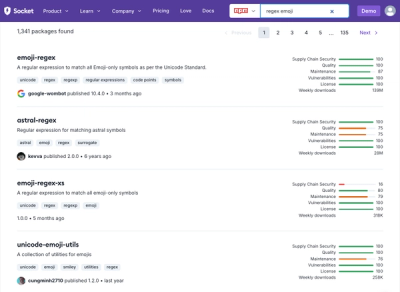
Research
Security News
Malicious npm Package Targets Solana Developers and Hijacks Funds
A malicious npm package targets Solana developers, rerouting funds in 2% of transactions to a hardcoded address.
.. image:: https://img.shields.io/pypi/v/xplant.svg :target: https://pypi.python.org/pypi/xplant :alt: Pypi Package Version .. image:: https://img.shields.io/pypi/pyversions/xplant.svg :target: https://pypi.python.org/pypi/xplant :alt: Supported Python Versions .. image:: https://img.shields.io/pypi/wheel/xplant.svg :target: https://pypi.python.org/pypi/xplant :alt: Wheel support .. image:: https://img.shields.io/pypi/format/xplant.svg :target: https://pypi.python.org/pypi/xplant :alt: Package format .. image:: https://img.shields.io/pypi/l/xplant.svg :target: https://pypi.python.org/pypi/xplant :alt: License info .. image:: https://img.shields.io/pypi/status/xplant.svg :target: https://pypi.python.org/pypi/xplant :alt: Package status .. image:: https://img.shields.io/gitlab/pipeline/kamichal/xplant.svg :target: https://gitlab.com/kamichal/xplant/-/pipelines :alt: Pipeline status
Pure pythonic tree structure builder and markup language translator. No dependencies, quite fast, pretty syntax, no templates.
str on it.Basically it's suited for XML and similar markups (SVG, HTML) but it can be used for probably any structured markup.
Written mostly to be an python inline html generator.
.. code:: python
from xplant import xml_plant
x = xml_plant()
with x.node("section_a", attribute_1=1):
with x.node("nested_1", empty=True):
pass
with x.node("nested_2"):
x.comment("Can handle also comments.")
for number in range(3):
x.leaf("a_number_{:02}".format(number), num=number)
Will give:
.. code:: xml
<?xml version="1.0" encoding="utf-8"?>
<section_a attribute_1="1">
<nested_1 empty="true"></nested_1>
<nested_2>
<!-- Can handle also comments. -->
<a_number_00 num="0" />
<a_number_01 num="1" />
<a_number_02 num="2" />
</nested_2>
</section_a>
.. code:: python
css = """
ul.navigation {
list-style-type: none;
margin: 0;
padding: 0;
overflow: hidden;
background-color: #f2fff5;
}
li {
float: left;
}
li a {
display: block;
color: white;
text-align: center;
padding: 14px 16px;
text-decoration: none;
}
code {
background-color: #ded;
padding: 4px;
border-radius: 3px;
}
"""
navigation = [
("Home", "../home.html", "red"),
("Things", "stuff.html", "green"),
("About", "../about.html", "blue"),
]
text = [
"This page has ben generated with python's <code> xplant.html.html5_plant </code>.",
"Enjoy pure pythonic <code>1:1 python -> xml</code> translation.",
"break",
"Did you ever had hard times with learning <code>HTML template language</code>? ",
"It's a crude way to mix HTML with any logics like iterators, classes, conditions.",
"break",
"You know what? You already have all of it (and much more) in <code>python</code>! ",
"HTML templates is a blind alley. HTML does not miss server-side scripting.",
"The python miss a good HTML generator not vice versa.",
]
from xplant import html5_plant
x = html5_plant()
with x.html():
with x.head():
x.meta(charset="utf-8")
x.meta(http_equiv="Content-Security-Policy")
x.line("title", "no templates, no headache")
# line is a helper for creating text in a xml tag
with x.style():
x.text(css)
with x.body(style="margin:28px;"):
with x.header():
x.line("h2", "XPLANT", id="title")
x.line("h4", "It makes good things for you")
x.comment("HERE COMES THE NAVIGATION")
with x.ul(id="navigation"):
x.comment("CHECK OUT THIS LIST")
for name, link_url, link_color in navigation:
with x.li():
with x.a(href=link_url, style="color:%s;" % link_color):
x.text("%s in %s" % (name, link_color))
x.comment("HERE COMES MAIN SECTION")
with x.main(style="margin:20px;"):
for paragraph in text:
with x.p():
if paragraph == "break":
x.br()
else:
x.text(paragraph)
print(p)
Gives such a string:
.. code:: html
<!DOCTYPE html>
<html>
<head>
<meta charset="utf-8" />
<meta http-equiv="Content-Security-Policy" />
<title>no templates, no headache</title>
<style>
ul.navigation {
list-style-type: none;
margin: 0;
padding: 0;
overflow: hidden;
background-color: #f2fff5;
}
li {
float: left;
}
li a {
display: block;
color: white;
text-align: center;
padding: 14px 16px;
text-decoration: none;
}
code {
background-color: #ded;
padding: 4px;
border-radius: 3px;
}
</style>
</head>
<body style="margin:28px;">
<header>
<h2 id="title">XPLANT</h2>
<h4>It makes good things for you</h4>
</header>
<!-- HERE COMES THE NAVIGATION -->
<ul id="navigation">
<!-- CHECK OUT THIS LIST -->
<li><a href="../home.html" style="color:red;">Home in red</a></li>
<li><a href="stuff.html" style="color:green;">Things in green</a></li>
<li><a href="../about.html" style="color:blue;">About in blue</a></li>
</ul>
<!-- HERE COMES MAIN SECTION -->
<main style="margin:20px;">
<p>This page has ben generated with python's <code> xplant.html.html5_plant </code>.</p>
<p>Enjoy pure pythonic <code>1:1 python -> xml</code> translation.</p>
<p><br /></p>
<p>Did you ever had hard times with learning <code>HTML template language</code>? </p>
<p>It's a crude way to mix HTML with any logics like iterators, classes, conditions.</p>
<p><br /></p>
<p>You know what? You already have all of it (and much more) in <code>python</code>! </p>
<p>HTML templates is a blind alley. HTML does not miss server-side scripting.</p>
<p>The python miss a good HTML generator not vice versa.</p>
</main>
</body>
</html>
FAQs
Tree model markup builder.
We found that xplant demonstrated a healthy version release cadence and project activity because the last version was released less than a year ago. It has 1 open source maintainer collaborating on the project.
Did you know?

Socket for GitHub automatically highlights issues in each pull request and monitors the health of all your open source dependencies. Discover the contents of your packages and block harmful activity before you install or update your dependencies.

Research
Security News
A malicious npm package targets Solana developers, rerouting funds in 2% of transactions to a hardcoded address.

Security News
Research
Socket researchers have discovered malicious npm packages targeting crypto developers, stealing credentials and wallet data using spyware delivered through typosquats of popular cryptographic libraries.

Security News
Socket's package search now displays weekly downloads for npm packages, helping developers quickly assess popularity and make more informed decisions.